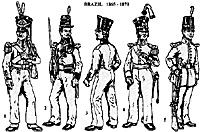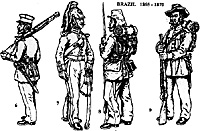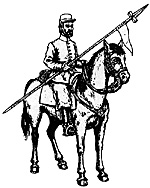Other Installments:
-
Imperial Brazilian Uniforms (Part 1): Line Infantry
Imperial Brazilian Uniforms (Part 2): Line Cavalry
Imperial Brazilian Uniforms (Part 3): Artillery
Imperial Brazilian Uniforms (Part 4): General Staff and Engineers
Imperial Brazilian Uniforms (Part 5): "Fixed" or Garrison Corps
As noted in Part 1 of this series the "Guardia Nacional" or National Guard, was the largest single source of manpower for the Brazilian armies during the War of the Triple Alliance. Unfortunately, this is also the force on which the least information is available. "Barroso" included a small section devoted to the "Guardia" at the end of his book, but it totals only 3½ pages of text and 6 plates to cover the entire history of the force. Accordingly, I've included a few figures from other sources in this segment in an attempt to fill some of the gaps, but coverage remains sketchy.
During the 1825-28 War with Argentina, Brazilian reserves and second-line forces were provided by a hodgepodge of militias, "Ordenanças", municipal guards, etc., with little standardisation or co-ordination between them. Needless to say, their performance during the war left a good deal to be desired. After the war it was decided to abolish all these miscellaneous corps and replace them with a single standardised reserve force. Accordingly, the Decree of 18th August, 1831, created the "Guardia Nacional" with a unified line comprising the 3 major combat arms; infantry, cavalry and artillery.
Each infantry battalion was to include 2 companies of Cacadores, but there was to be no separate corps of these troops. These units were to be recruited, organised and administered by the individual provinces, which necessarily led to some diminution of the expected standardisation.. The Imperial Court also raised it's own National Guard units from the country at large, as if it were a province in it's own right. These units "of the Court" tended to be better trained and equipped than ordinary provincial units, and seem to have often served as "model" units for the corps as a whole.
The "Guardia" was completely reorganised in 1851, when a range of new uniforms were introduced. The 1851 Dress Regulations were accompanied by an album of explanatory lithographs which form the basis for a number of the "Barroso" plates, though there is little additional information in the text on these uniforms. Despite some alterations during the period 1858-1865 these basic uniforms appear to have still been in use in 1865, at the time of the outbreak of the War of the Triple Alliance.
In 1865, by Decree Nr. 3,383, some 14,796 Guardias Nacionales were mobilised for war service; some to be sent to join the field armies, others to perform "police" functions behind the lines or relieve regular troops in provincial garrisons. The National Guard continued to recruit throughout the war, as the demand for units for duties of all sorts continued to grow.
To the best of my knowledge there are no available figures on how many National Guards were eventually mobilised. "Barroso" provides a hint by noting that the province of Rio Grande do Sul mobilised a total of 43,500 National Guards during the war, of which 29,200 saw combat. Equally, I know of no complete listing of the number of units raised. This is probably not too surprising considering that the war seems to have seen a continual process of unit raisings, disbandings, amalgamations, re-numberings, etc., to the point where even attempting to follow the history of a single unit can be tortuous.
To complicate the picture even more, there was also a range of units designated as "Provisional Corps" which seem to have been considered part of the National Guard. Available evidence suggests these were ad-hoc units formed of drafts from various sources and "provisionally" attached to the regular line, though their exact status remains unclear.
Uniforms
In the area of uniforms, the outbreak of war saw a fairly rapid disappearance of the last of the fancy, and rather old-fashioned, 1851 uniforms. No new dress regulation was ever promulgated for the National Guard during the war; the matter seems to have been generally left to the individual provinces. As a general rule National Guard units seem to have worn uniforms based on those of the regular army, but simplified and plainer, with little extraneous decoration.
As with the regulars, field improvisations were wide-spread on campaign, and many units seem to have been largely dressed in civilian clothing (whether they started out that way, or this was entirely due to shortages of replacement uniforms is another question?). They seem to have worn roughly the same range of dark blue woollen winter and white cotton summer uniforms as the regular army, with little indication of the use of the brown drill working uniform.
 FIG.1: National Guard Infantry Fusilier, Model 1851, Full Dress: Black
shako with brass "sunburst" plate bearing the provincial unit number, national
cockade, red plume and white cords. Dark blue coatee with white collar, cuff flaps and
skirt linings, red cuffs and piping edging the collar, cuff flaps and front opening, brass buttons, a yellow "disc" on either side of the collar, and epaulets with red strap
and pad, brass crescents with white fringe. White belts, trousers, gaiters and gloves. The collar "disc" is a feature of most of the 1851 uniforms depicted, but is not explained in the text. I would suspect it to be the "world globe" from the Brazilian coat of arms, possibly embroidered, though they could also conceivably be of metal.
FIG.1: National Guard Infantry Fusilier, Model 1851, Full Dress: Black
shako with brass "sunburst" plate bearing the provincial unit number, national
cockade, red plume and white cords. Dark blue coatee with white collar, cuff flaps and
skirt linings, red cuffs and piping edging the collar, cuff flaps and front opening, brass buttons, a yellow "disc" on either side of the collar, and epaulets with red strap
and pad, brass crescents with white fringe. White belts, trousers, gaiters and gloves. The collar "disc" is a feature of most of the 1851 uniforms depicted, but is not explained in the text. I would suspect it to be the "world globe" from the Brazilian coat of arms, possibly embroidered, though they could also conceivably be of metal.
Large Illustration Uniform Figures 1-5 (slow: 91K)
FIG.2: National Guard Cacador, Model 1851, Full Dress: Black conical shako with brass bugle and Imperial crown on the front, national cockade and dark green plume, wrapped with black cords. Dark green coatee with black collar and cuffs, white skirt linings, brass buttons, dark green contre-epaulets with brass crescents, white discs on the collar. White trousers and gloves, black belts. Curiously, this is the only dark green uniform depicted in "Barroso" among the various Model 1851 uniforms. A Cacador officer depicted wears an almost identical uniform (barring the distinction of rank), except that his coatee appears to be dark blue, rather than green. An officer and Cacador depicted in "second uniform" are also dressed in dark blue. Assuming this is not simply a printing error, I could not even hazard a guess as to the reason for this variation. It is unclear if these Cacador companies survived the re-organisation of the National Guard in 1865-66, personally, I suspect they were probably "standardised" out of existence at this point.
FIG.3: Cacador, Model 1851, Second Uniform (undress): Wide topped shako in black oil-cloth cover fastened by a row of brass buttons down the side. Dark blue waist-length jacket with black collar and cuff flaps, brass buttons, white collar disc and trousers. These "Second Uniforms" would probably have constituted the field uniforms of the period and show considerable variation from one branch to another. The totally different shako model worn with undress remains totally unexplained. An officer depicted in "Second Uniform" wears a similar uniform, but with a tunic in place of the jacket, having a gold rank stripe circling the cuff.
FIG.4: National Guard Artillery Officer, Model 1851, Full Dress: Black shako with gilt plate and chin-scales, national cockade, red "waterfall" plume issuing from a black ball pompom. Dark blue coatee with what appears to be dark green collar and cuffs (though they might be intended as black, or discoloured), both edged with red piping, red tail lining and turnbacks, gold buttons, epaulets and collar discs. Red or crimson waist- sash (with tassels on the right hip), white trousers, black gloves, sabre with gold knot on a white bandolier with gilt breast plate.
FIG.5: National Guard Reserve Infantryman, Model 1851, Full Dress: Black cylindrical shako which appears to be covered with oilcloth, brass elongated star plate and chin-scales, national cockade and white plume. Dark blue tunic with dark blue collar and cuffs, all edged with white piping, white collar discs, brass buttons, dark blue contra- epaulets with white strap edging and brass crescents. White trousers and gloves, black waist-belt and musket strap.
 FIG.6: National Guard Reserve Infantryman, Model 1851, Second Uniform
(undress): Much the same uniform as fig.5. except that the shako is replaced by a dark blue cap
with yellow band, and the epaulets are missing. The rear skirts of the tunic have a
triple row of white vertical piping as well as piping edging the pocket flaps. I would
presume the brass-hilted side-arm depicted is a sword-bayonet, since no additional
bayonet is shown (on the other hand, no cartridge pouch is depicted either).
FIG.6: National Guard Reserve Infantryman, Model 1851, Second Uniform
(undress): Much the same uniform as fig.5. except that the shako is replaced by a dark blue cap
with yellow band, and the epaulets are missing. The rear skirts of the tunic have a
triple row of white vertical piping as well as piping edging the pocket flaps. I would
presume the brass-hilted side-arm depicted is a sword-bayonet, since no additional
bayonet is shown (on the other hand, no cartridge pouch is depicted either).
Large Illustration Uniform Figures 6-9 (slow: 85K)
FIG.7: Trooper, 1st National Guard Cavalry Regiment, "Of The Court", Full Dress, 1858: Steel helmet with brass crest, front badge and chin-scales, red horse-hair mane. Dark blue coatee with white collar and cuff flaps, both edged with red piping as are the dark blue cuffs and front opening, brass buttons and shoulder-scales, red turnbacks, 2 yellow lace loops on either side of the collar. Dark blue trousers with red double stripe, white belts with brass or gilded fittings, white gloves and sabre-knot.
The uniform depicted was newly adopted in 1858, apparently by this regiment only. According to the 1851 regulations, cavalry were to wear a wide-topped shako similar to that of other units. A trooper shown in "Barroso" of the "2nd Cavalry" c.1851 wears the shako with brass front plate and chin-scales, yellow lace encircling the top, and a rather short red plume. The rest of the uniform is much as depicted here except that the collar and cuff flaps are dark blue instead of white, the former with some sort of white device (possibly intended as the "world globe"). On the other hand, an officer depicted of the "1st Regiment" (not stated if this is the "Court" regiment or a provincial unit) in "Grande Gala" wears a red coatee with yellow collar and piping, red cuffs, green cuff flaps, gold buttons and epaulets of rank, black trousers with a red double stripe, and the shako with a "Waterfall plume" of red feathers. It would appear that more variation was allowed in the cavalry uniform.
FIG.8: National Guard Infantryman From A Unit Of "The Court", Campaign Dress, c.1865-70: From "Barroso", after a contemporary lithograph; Kepi covered by a white "Havelock". Plain dark blue tunic and trousers with brass buttons. Black belts, pouch, boots and musket strap, white breadbag. The pack appears to be of black canvas with an iron mess-tin strapped to the rear, and a black or dark grey roll to the top.
Fig.9: National Guard Infantryman, Campaign Dress, c.1865-70: From a contemporary newspaper engraving, described as "National Guards waiting to enter the line"; Although no colours are indicated, the uniforms are shaded and would most likely have been a plain dark blue with brass buttons. The upper garment is a sort of smock or "shirt" of a type which seems to have been widely worn by both National Guards and Volunteers; it generally had a pleated breast with a reinforcing yoke covering the upper breast and shoulders. Some models were open all the way down the front (as here), while others were only open to the waist and were pulled on over the head.
 FIG.10: "Lancero Regiment da Rio Grande do Sul", Campaign Dress, c.1865-70: From a
water colour sketch in the National Historical Museum, Rio de Janeiro; Although
not designated as National Guard in the title, it seems likely that is what this figure is. White kepi cover and chinstrap, black front peak. Plain dark blue tunic with brass buttons; just visible under his right hand is the circular brass plate of his narrow black waistbelt. White trousers tucked into black boots. Brown saddle, black straps, dark blue saddle blanket and mantle roll. His lance has quite a large steel blade and a plain red pennon.
FIG.10: "Lancero Regiment da Rio Grande do Sul", Campaign Dress, c.1865-70: From a
water colour sketch in the National Historical Museum, Rio de Janeiro; Although
not designated as National Guard in the title, it seems likely that is what this figure is. White kepi cover and chinstrap, black front peak. Plain dark blue tunic with brass buttons; just visible under his right hand is the circular brass plate of his narrow black waistbelt. White trousers tucked into black boots. Brown saddle, black straps, dark blue saddle blanket and mantle roll. His lance has quite a large steel blade and a plain red pennon.
Large Illustration Uniform Figure 10 (slow: 69K)
FIG.11: National Guard Cavalryman, Campaign, c.1865-70: Also from a newspaper engraving: The uniform is unshaded and would probably be a plain white cotton summer uniform, hat, belts and boots appear to be black. Note the sabre slings hooked together, whether this indicates some shortage of weapons, or that the sabre has simply been left in the man's tent as an encumbrance is unclear.
Large Illustration Uniform Figures 11-14 (slow: 92K)
 Finally, "Barroso" depicts 3 figures from what he describes as "The celebrated Provisional Corps of National Guard Cavalry forming the Division of General Andrade Neves". These units were recruited in Rio Grande do Sul province and seem to have largely worn the local gaucho-style dress.
Finally, "Barroso" depicts 3 figures from what he describes as "The celebrated Provisional Corps of National Guard Cavalry forming the Division of General Andrade Neves". These units were recruited in Rio Grande do Sul province and seem to have largely worn the local gaucho-style dress.
FIG.12: "Provincial" Cavalryman, c.1866-70: This figure, sipping his Maté through a straw, wears a curious red hat with the turned-up front brim showing a black lining (possibly leather), white cords circling the crown and hanging as chin-cords, open black jacket worn over a white shirt, loose red "bombacho" trousers depicted as having a convoluted strip in the same colour down the outer side (some sort of lace or embroidery), soft heel-less boots of natural leather. A dark brown fringed blanket or poncho is wrapped around his shoulders, the ends decorated with alternating stripes of black and ochre yellow. A brown bag of some sort, possibly leather, hangs on his right hip, entirely steel sabre with black leather strap and knot.
FIG.13: "Provisional" Cavalryman, c.1866-70: Black hat with yellow chin-cords, the visible part of the hatband appears mainly white, but might well be an attempt to depict a highlight on a dark leather band. Plain dark blue jacket worn over a red shirt, light pink neckerchief, white trousers, dark brown boots, a wide dark brown leather waistbelt with the divided ends fastening with 3 small brass buckles. A fringed yellowish-brown blanket or poncho, the ends decorated with 3 mid-brown stripes, is slung over his right shoulder. Hanging from his left wrist are natural leather straps used as a horsewhip.
FIG.14: "Provincial" Cavalryman, c.1866-70: Brown hat with a white cord (or conceivably a thin small chain) going under his nose, worn over a red head-scarf. Plain lightish brown poncho, black trousers, natural leather boots, dark brown sabre-knot. Visible at the neck, under the poncho, is what appears to be some sort of red scarf, but this is poorly delineated and might be intended to be a shirt.
Other Installments:
-
Imperial Brazilian Uniforms (Part 1): Line Infantry
Imperial Brazilian Uniforms (Part 2): Line Cavalry
Imperial Brazilian Uniforms (Part 3): Artillery
Imperial Brazilian Uniforms (Part 4): General Staff and Engineers
Imperial Brazilian Uniforms (Part 5): "Fixed" or Garrison Corps
Back to Table of Contents -- El Dorado Vol VIII No. 3
Back to El Dorado List of Issues
Back to MagWeb Master Magazine List
© Copyright 1998 by The South and Central Military Historians Society
This article appears in MagWeb (Magazine Web) on the Internet World Wide Web.
Other military history articles and gaming articles are available at http://www.magweb.com